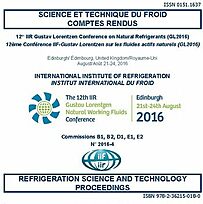
IIR document
Evaluation of different evaporator and condenser concepts in sea water chillers using CO2 as refrigerant.
Number: pap. 1119
Author(s) : REKSTAD I. H., LADAM Y.
Summary
On board cooling of pelagic fish has often been performed using a Refrigerated Sea Water (RSW) refrigeration plant with halocarbon HCFC 22 as working fluid. According to EU-regulations, refilling of this fluid is not allowed from 2015. HFC alternatives may have considerable greenhouse warming potential and are heavily taxed in some countries, thus only a short time solution. The main natural alternative, ammonia, has significant drawbacks that can be unacceptable particularly for smaller vessels and for rebuilding of existing ships. Carbon Dioxide (CO2) is an environmental friendly, inexpensive, non-toxic, non-flammable alternative. One drawback is the high operating pressure which could give heavy, bulky and expensive heat exchangers. Different CO2-evaporator and condenser solutions were installed and tested on three fishing boats. One boat has pillow (dimple) plates and two boats have tube in shell type with either CO2 on shell side or CO2 inside tubes. This paper presents and compares the different heat exchanger solutions and boat owners experience using the CO2 RSW-system.
Available documents
Format PDF
Pages: 7 p.
Available
Public price
20 €
Member price*
Free
* Best rate depending on membership category (see the detailed benefits of individual and corporate memberships).
Details
- Original title: Evaluation of different evaporator and condenser concepts in sea water chillers using CO2 as refrigerant.
- Record ID : 30019089
- Languages: English
- Source: 12th IIR Gustav Lorentzen Conference on Natural Refrigerants (GL2016). Proceedings. Édimbourg, United Kingdom, August 21st-24th 2016.
- Publication date: 2016/08/21
- DOI: http://dx.doi.org/10.18462/iir.gl.2016.1119
Links
See other articles from the proceedings (140)
See the conference proceedings
Indexing
-
Themes:
Evaporators, condensers and other heat exchangers;
Marine transport;
CO2 - Keywords: Sea transport; R744; Evaporator; Testing; Condenser; Sea water
-
High efficiency air cooled heat exchangers for ...
- Author(s) : FILIPPINI S., MERLO U., MARIANI G., et al.
- Date : 2019/08/24
- Languages : English
- Source: Proceedings of the 25th IIR International Congress of Refrigeration: Montréal , Canada, August 24-30, 2019.
- Formats : PDF
View record
-
DETERMINATION OF EXERGETIC EFFICIENCY FOR EVAPO...
- Author(s) : MARKOSKI M., HRNJAK P.
- Date : 1987/08/24
- Languages : English
- Source: Development in refrigeration, refrigeration for development. Proceedings of the XVIIth international Congress of Refrigeration.
- Formats : PDF
View record
-
Medium-scale uniform pressure tests on first-ye...
- Author(s) : MASTERSON D. M., SPENCER P. A., FREDERKING R. M. W.
- Date : 1994/05/02
- Languages : English
View record
-
JET-CENTRIFUGAL ATOMIZER IN APPLICATION TO SPRA...
- Author(s) : PRYWER J., KULESZA J.
- Date : 1987/08/24
- Languages : English
- Source: Development in refrigeration, refrigeration for development. Proceedings of the XVIIth international Congress of Refrigeration.
- Formats : PDF
View record
-
Experimental investigation of evaporators with ...
- Author(s) : OKBAZ A., SOKUCU M. H., ONBASIOGLU H., et al.
- Date : 2019/04/11
- Languages : English
- Source: 8th Conference on Ammonia and CO2 Refrigeration Technology. Proceedings: Ohrid, North Macedonia, Avril 11-13, 2019.
- Formats : PDF
View record
